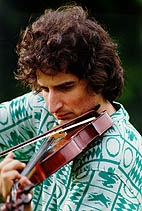|
Sometimes
when I pull out my baroque violin at a concert or music
session, people ask how it's different from a modern violin.
Here are some answers....
The modern violin is under
more tension than the baroque violin, for various reasons:
the neck is angled more sharply, the pieces of wood that
help the vibrations get where they need to go are smaller or
thinner (i.e., bridge, sound post, bass bar), and the
strings are tuned higher (standard modern pitch is a
half-tone higher than standard baroque pitch). The result of
this tension difference is a difference in the force
necessary to make the violin come alive. The baroque violin
responds to the slightest touch, and incredibly subtle
nuances are possible at a quiet-to-moderate dynamic range.
But on the other hand, the sound 'breaks' past a certain
force of playing. The modern violin needs more force to get
a good-sounding response. Subtle nuances are possible at
moderate-to-loud dynamic range, but as you play softer, the
sound becomes hoarse (not enough force to get a good tone).
However, on a modern violin you can use just about as much
force as you can crank out, which in most non-classical
venues is not nearly enough! It's almost always amplified to
sound exponentially louder than its acoustic potential, in
today's public traditional music events.
Early bows (1600-1750)
have no standard length, but they are all shorter than
modern bows. They are less cambered or non-cambered (i.e.,
not curved towards the hair in the middle of the bow), and
they taper off to a point at the tip of the bow. The lighter
weight of the early bow, due to less wood at the tip and
shorter length, matches the lighter touch needed to make the
baroque violin awaken.
Transitional bows
(1725-1800) are somewhere in between baroque and modern bows
in construction. Modern bows (1800-present) have a standard
length (longer) and a standard shape within subtly different
styles of bow making. They are cambered more (have an
increased curve toward the hair in middle of bow) and have
an elbow at the tip of the bow. There is also a metal
ferrule at the frog and metal in the tightening screw. The
heavier weight matches the heavier touch needed to make the
modern violin resonate.
There are differences in
playing techniques between baroque and modern violin. On a
baroque violin, lots of energy and intensity can be used,
and since the baroque violin reacts to light touches, much
baroque music involves lightening-fast bowing and
articulation. For slower passages, the baroque player is
mostly 'coasting' or 'hanging' the bow lightly on the
string, moving the bow just fast enough to keep the desired
sound going. It is mainly the start of the stroke that gets
pressure/weight/thrust, and an immediate release of pressure
is required following nearly all bowstroke beginnings.
Obviously, on a modern violin, lots of energy and intensity
can be used as well, but since the modern violin reacts to
heavy touches, most of the time the player is 'digging in'
with the bow more often and more continuously.
How about holding the
different violins and bows? A baroque violin is held
balanced between the top of the collar bone (note no
chinrest!) and the left hand. The great freedom of motion
that this hold makes available works well with the light
touch required. Conversely, a modern violin usually is more
'wedged in' under the chin or left jaw and shoulder, often
with the aid of a shoulder rest. The tighter hold works for
the heavier touch/force needed. Finally, the baroque bow is
held loosely with right wrist bent up, while the modern bow
is held not so loosely with the right wrist straighter. Of
course, folk fiddle players often develop their own way of
holding the violin and bow that is often very
personalized!
Don't forget that in the
baroque era, the folk violinists used baroque violins and
bows, and gut strings. I find that the accents, ornaments,
bowstrokes, and articulations that make the Cape Breton
style so spirited and heartfelt can be accomplished on the
baroque violin setup using much less force. Only... it's
better suited to a living room rather than a modern dance
hall.
|
